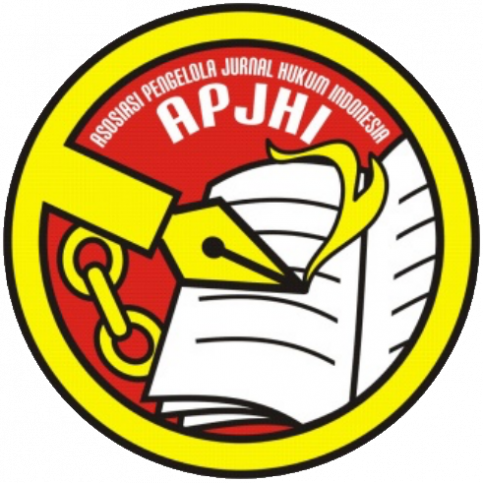CONFIGURATION OF A SIMULTANEOUS-SEPARATE GENERAL ELECTION SYSTEM TO STRENGTHEN THE CHARACTER OF AN INCLUSIVE GOVERNMENT SYSTEM IN INDONESIA
Abstract
Full Text:
PDFReferences
Allen Hicken and Heater Stoll, “Elektoral Rules and the Size of the Prize: How Political Institutions Shape Presidential Party System”, The Journal of Politics, 70 (2009), h. 1109-1110.
Arend Lijphart, Democracy in Plural Societies, A Comparative Exploration, New Haven and London, (USA: Yale University Press, 1977).
Ben Reilly dan Andrew Reynolds, Sistem Pemilu, IDEA, (USA: International Stockhlom, 2001).
Fitra Arsil, Teori Sitem Pemerintahan: Pergeseran Konsep dan Saling Kontribusi Antar Sistem Pemerintahan di Berbagai Negara, (Depok, RajaGrafindo Persada, 2017).
Fajlurrahman Jurdi, Pengantar Hukum Pemilihan Umum, (Jakarta: Prenamedia Group, 2018).
Jimly Asshiddiqie, Pergulaman Peran Pemerintah dan Parlemen dalam Sejarah: Telaah Perbandingan Konstitusi Berbagai Negara, (Jakarta: UI Press, 1996).
Joeniarto, Perkembangan Pemerintahan Lokal, (Jakarta: Bina Aksara, 1992)
E. Abdul Latief, “Pilpres dalam Perspektif Koalisi Multipartai”, Jurnal Konstitusi Vol. 6 No. 3, September (2009) Efriza, “Penguatan Sistem Presidensial dalam Pemilu Serentak 2019”, Jurnal Penelitian Politik, Vol. 16 No. 1 (Juni 2019).
Fitra Arsil, “Stabilitas Sistem Presidensial Indonesia melalui Pemilihan Umum Serentak dan Presidential Threshold, Jurnal Ketatanegaraan, Vol. 05, (2017).
Heroik Muttaqin Pratama, “Menguji Desain Pemilu Serentak: Studi Perbandingan Amerika Latin dan Indonesia dalam Analisis CSIC”, Tantangan Desain Pemilu Serentak, Vol. 46 No. 4 (2017).
Hayatun Na’Imah, “Perda Berbasis Syariah dan Hubungan Negara-Agama dalam Perspektif Pancasila”, Mazahib, Vol. XV, Nomor 2.
Kementerian Dalam Negeri Republik Indonesia, Naskah Akdemik Rancangan Undang-Undang tentang Penyelengaraan Pemilihan Umum, Tahun 2016 dalam Fajlurrahman Jurdi, Pengantar Hukum Pemilihan Umum.
Kementerian Dalam Negeri Republik Indonesia, Naskah Akademik Undang-Undang.
Kusnardi dan Harmaily Ibrahim, Pengantar Hukum Tata Negara Indonesia, (Jakarta: Pusat Studi Hukum Tata Negara Fakultas Hukum Universitas Indonesia, 1978).
Mark P Jones, Electoral Laws and the Survival of Presidential Democraties, (Notre Dame: University of Notre Dame Press, 1995).
Mahkamah Konstitusi Republik Indonesia, Permohonan Nomor Perkara 37/PUU-XVII/2019.
Mahkamah Konstitusi Republik Indonesia, Mendengarkan Keterangan DPR, KPU, Bawaslu, DKPP dan Ahli yang dihadirkan oleh Mahkamah, Risalah Sidang IV Perkara Nomor 37/PUU-XVII/2019 pada 17 Oktober 2019.
Mahkamah Konstitusi Republik Indonesia, Permohonan Nomor Perkara 55/PUU-XVII/2019.
Mahkamah Konstitusi Republik Indonesia, Ringkasan Permohonan, Perkara Nomor 14/PUU-XI/2013.
Mahkamah Konstitusi Republik Indonesia, Mendengar Keterangan Pemerintah, DPR, dan Saksi/Ahli dari Pemohon serta Pemerintah, Risalah Sidang III Perkara Nomor 14/PUU-XI/2013 pada 14 Maret 2013.
Mahkamah Konstitusi Republik Indonesia, Putusan Mahkamah Konstitusi Nomor 14/PUU-XI/2013.
Moh. Mahfud MD, Dasar dan Struktur Ketatanegaraan Indonesia, (Jakarta: Rineka Cipta, 2000).
Ni’matul Huda dan Iman Nasef, Penataan Demokrasi dan Pemilu di Indonesia Pasca Reformasi, (Jakarta: Kencana, 2017).
Peter Mahmud, Penelitian Hukum, Jakarta: Kencana, 2011.
Simatupang, R. S. A., Siagian, A. H., & Zulyadi, R. (2022). Kajian Hukum Terhadap Anak Yang Melakukan Tindak Pidana Narkotika Dalam Perspektif Kriminologi Studi di Polresta Deli Serdang. Journal of Education, Humaniora and Social Sciences (JEHSS), 5(2), 1137-1146.
Soerjono Soekanto & Sri Mamudji, 2012. Penelitian Hukum Normatif Suatu Tinjauan Singkat, Rajawali Pers, Jakarta.
Wasis Susetyo, Laporan Akhir Pengkajian Hukum tentang Tinjauan Terhadap Efisiensi Pelaksanaan Pemilu di Indonesia, (Jakarta: Pusat Penelitian dan Pengembangan Sistem Hukum Nasional BPHN Kemenkumham RI, 2015).
DOI: http://dx.doi.org/10.31000/jhr.v11i2.9215
Article Metrics
Abstract - 731 PDF - 447Refbacks
- There are currently no refbacks.

This work is licensed under a Creative Commons Attribution-ShareAlike 4.0 International License.

